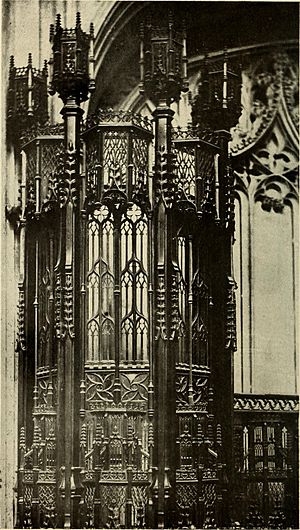John Tresilian facts for kids
John Tresilian was a super-skilled metalworker, also known as a master smith, who lived a long time ago, around the late 1400s and early 1500s. He was so good at his craft that he even worked for King Edward IV of England! Most of what we know about him comes from old papers found at Windsor Castle and the amazing metal pieces he made that are still around today.
Who Was John Tresilian?
Tresilian's exact birth and death dates are a bit of a mystery, but we know he was active from about 1450 to after 1515. His name, Tresilian, sounds like it comes from Cornwall, a county in England.
Working for the King
Official records show that John Tresilian was a "principal smith" at Windsor Castle from 1477 to 1484. This means he was one of the most important metalworkers there. He earned about 16 pence a day, which was a good wage back then.
In 1479, documents mention him helping to create a very large anvil that was brought to Windsor. Anvils are heavy blocks of metal that blacksmiths use to hammer and shape other metals. Later, in 1515, King Edward IV's payment records show Tresilian was paid for making a clock. He probably passed away a few years after that. Another smith named Anthony Trassillion took over his work, and he might have been John's son.
Amazing Metalwork
We can also learn about Tresilian from the unique style of his metalwork. Experts believe he helped make the beautiful gates for King Edward IV's tomb. He also created special metal decorations for the doors of the king's private chapel, called a chantry, at St. George's Chapel in Windsor. He worked on these pieces between 1477 and 1484.
For a long time, people thought a different artist, Quentin Metsys, had made these works. But now, based on the craftsmanship, we know they were Tresilian's. Other pieces believed to be his include the lock and ring plates on the door of Edward IV's chantry, and similar plates that were once on the north and south sides of the choir. He also worked on the offertory for Henry VI of England.


